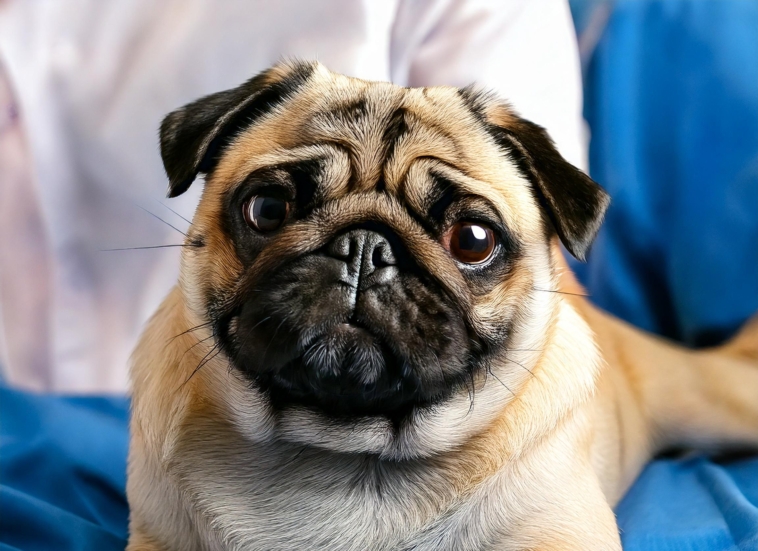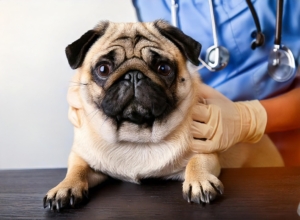The Hilarious (But Real) Guide to Health Issues in Pugs
Pugs: the living, snorting, waddling definition of “cute overload.” With their squished faces, googly eyes, and snore-like-a-freight-train charm, they’ve taken over hearts and couches everywhere. But behind those wrinkle-filled mugs lies a medical mystery series that’s more drama than comedy. Don’t worry though we’ve got the script.
The Pug Body Adorable and… Slightly Flawed
They didn’t choose the brachycephalic life, the brachycephalic life chose them. Unfortunately, it also chose:
- Short Muzzles – Breathing? Optional. Who needs nostrils that actually do anything?
- Wrinkled Skin – Cute? Yes. Moisture-trapping bacteria hotels? Also yes.
- Bulging Eyes – Gives them that “always surprised” look, but it’s a dry-eye disaster waiting to happen.
- Compact Body – Built like a loaf, which means they’re prone to puffing up like a second loaf if you’re not careful.
Knowing this anatomy is key to managing your pug’s health. Basically, you’re not just a pet owner. You’re a part-time nurse with a minor in snore interpretation.
Breathing Optional But Important
Pugs have what’s called Brachycephalic Obstructive Airway Syndrome, or what we call: “Why is my dog louder than a jet engine at 3am?”
Symptoms:
- Labored breathing during a hot day or casual jog. Yep, that 10-foot walk was basically a marathon.
- Snorting, sneezing, and various gagging. It’s like living with a tiny, confused piglet.
- Snoring louder than your grandfather. Bonus points if they wake themselves up.
Solutions:
- Keep them cool. AC is now their best friend.
- Take short walks, not hikes. Leave Everest to someone with a better airflow.
- Discuss surgery. “Stenotic nares” surgery can open up their nasal passages. Consider it a nose job that saves lives.
The Skin Saga: Wrinkles vs. The World
Behind each adorable face-roll lies a war zone of skin issues. Think of your pug as a cinnamon roll who’s uber, uber high maintenance.
Perpetrators:
- Food Allergies – Your pug is that foodie who can’t indulge in gluten, dairy, or joy.
- Yeast Infections – Damp skin folds are a fungus bash.
- Pyoderma – Insect bites that turn into breakout hot spots.
- Demodex Mange – Otherwise referred to as the “hair today, gone tomorrow” disease.
Treatments:
- Wipe those folds like you’re polishing fine china.
- Vet-approved antifungal shampoos are a must-use (and try hard not to use your cucumber-scented one).
- Say “no” to suspicious snacks and hypoallergenic diets are the way to go.
Pugs vs. Food: Obesity Battle Royale
They’ll act like they haven’t eaten in a decade, but trust us—they have.
Do This:
- Quality over quantity: Go for high-protein, low-calorie food.
- Hide your snacks like you’re in a spy movie.
- Swap fatty treats with healthy ones (low-fat peanut butter is their version of a Michelin star dessert).
- Pro tip: Regular vet weigh-ins are crucial. Think of them as pug weigh-ins, not weigh-downs.
Pug Allergies: The Drama Continues
Pugs are allergic to literally everything: pollen, cleaning sprays, air, Mondays…
Top Triggers:
- Environmental: Dust mites, mold, pollen (aka every season).
- Chemical: Cleaners, detergents, and pretty much anything that smells “fresh.”
- Food: Because of course they’re allergic to chicken and beef.
Solutions:
Get other pugs and tweak their lifestyle to resemble a health hypoallergenic as it is..
Bathe them with vet-recommended shampoos.
Antihistamines and medication as needed. (No, not your allergy medication.)
The Pug Heart Big Love, Small Ticker
Even their hearts are excessive.
Watch for:
- Chronic coughs (not just snoring’s evil relative).
- Fatigue (a pug who takes naps is okay—too much laziness is not).
- Swelling of the belly or fainting spells.
Doctor’s Orders:
- Regular heart check-ups.
- Cardio meds (ironically, not cardio exercise).
- Low-sodium diets and gentle exercise.
Vaccines & Vets: The Real MVPs
To keep your pug from getting something gross:
Vaccines They Need:
- Distemper (not just for drama queens).
- Parvo.
- Rabies (obviously).
- Bordetella (so they don’t cough up a hurricane like a possessed Victorian child).
Vet Visits:
- At least every other year. More if your pug is a diva.
- Vets notice quiet symptoms long before you do (pugs conceal problems behind their googly-eyed stares).
Lifestyle Tips: Keeping Your Pug From Becoming a Couch Potato With Asthma
Walk, do
- Walk, not run. Unless they are running from a sausage.
- Play, but not too much. Toy time > treadmill time.
- Fresh water at the faucet. Like a spa. But for snorty dogs.
Choosing a Vet: Swipe Right for Pug Physicians
- Check if they have experience with pugs (not just golden retrievers named Max).
- Ask for referrals from fellow pug people.
- Ensure that emergency care is offered. Pugs don’t so much time their issues
- Pugs don’t exactly time their problems.
Final Snort: Keep That Pug Healthy and Happy
Pugs are ambulatory joy bombs with more idiosyncrasies than the cast of a sitcom, but with proper care:
- Feed them properly.
- Look out for the drama signals (i.e., health symptoms).
- Visit the vet with regularity.
- Skip hot weather exercise.
- Treat them like the royalty they think they are.
- For with pugs, it’s all snorts and laughter ????





